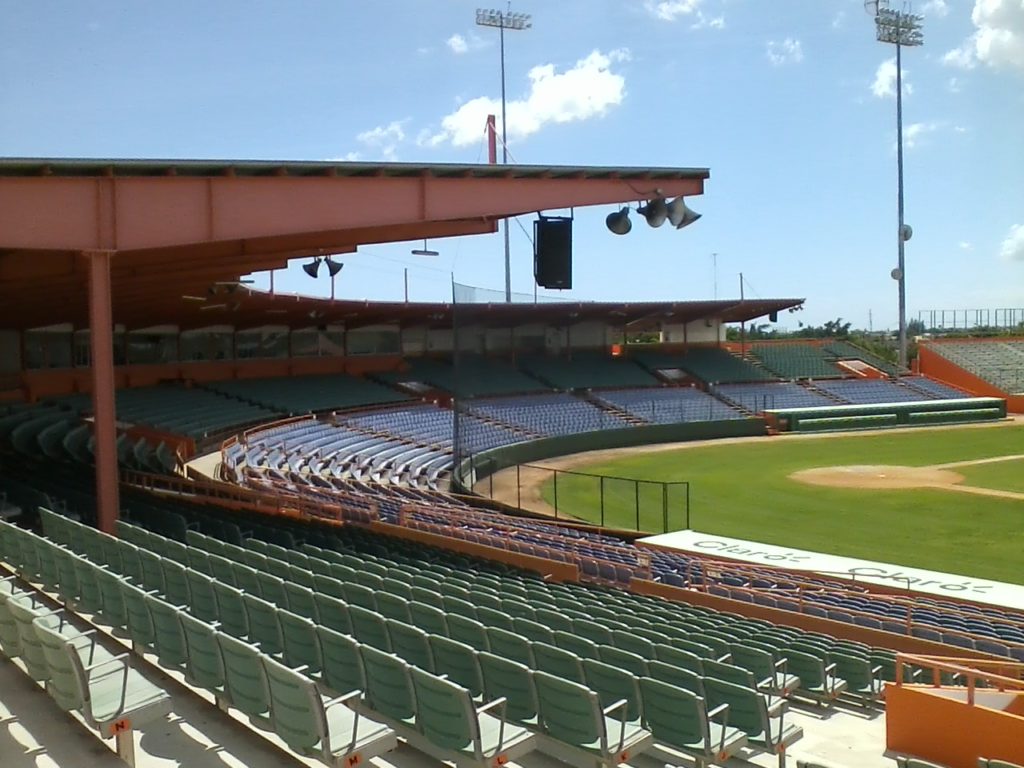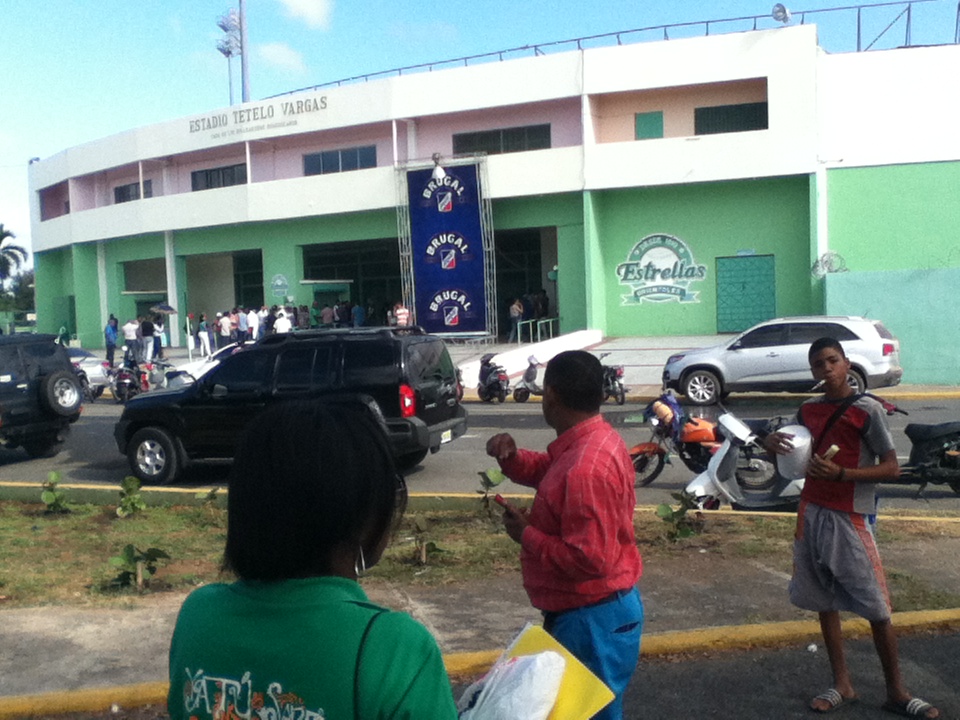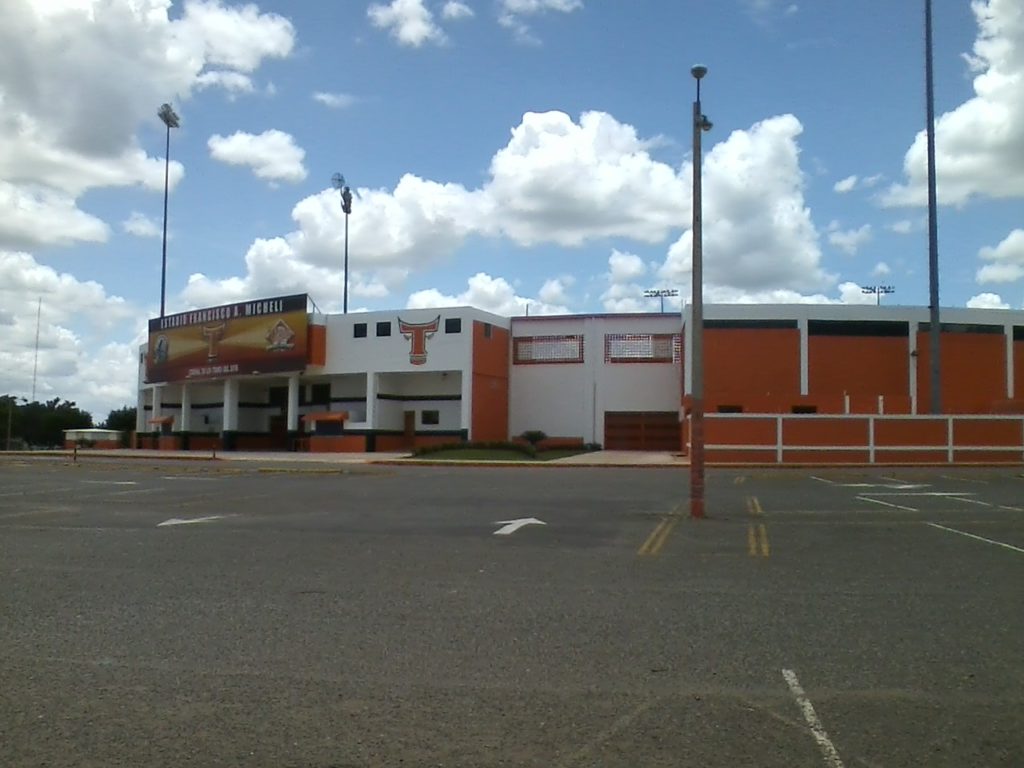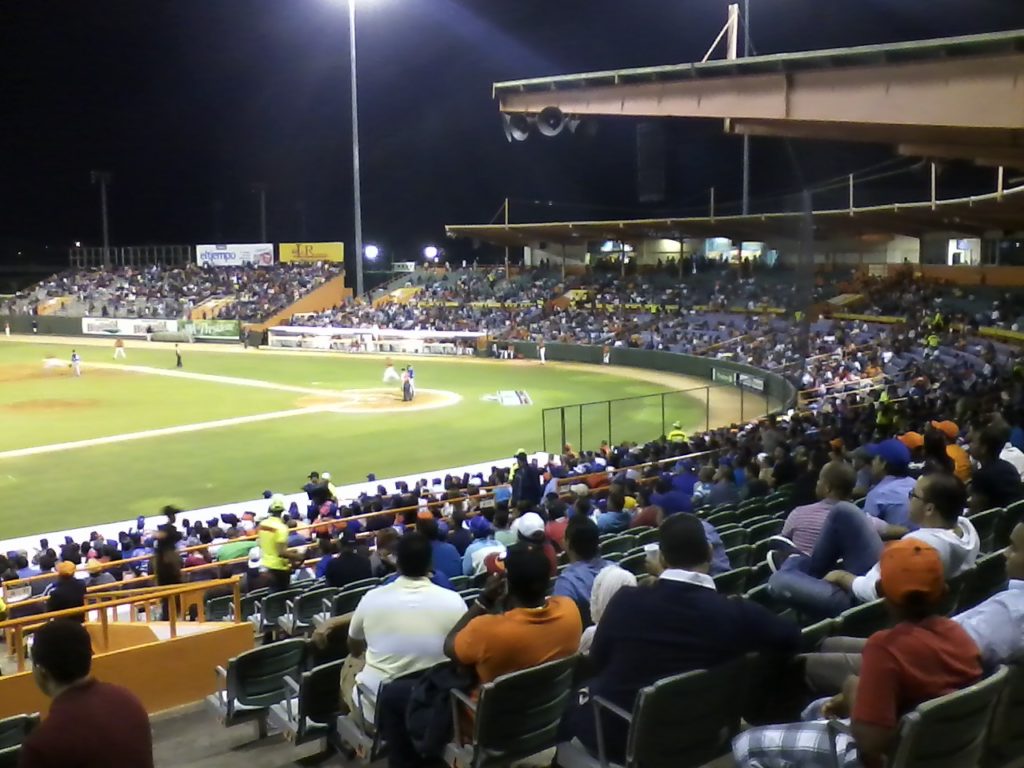Editor’s Note: Mark Cryan, former MiLB general manager and Ballpark Digest contributing editor, is releasing a series on his travels to the ballparks of the Dominican Winter League. What is part two of his three-part installment.
The World Series is over, the weather is turning colder, and baseball fans, like Rogers Hornsby said, are preparing to “stare out the window and wait for spring.” But, you don’t have to wait until spring training to feed your baseball addiction. The Dominican Winter League is just a short plane ride away!
There is no place in the world where baseball courses through the veins of the nation like the Dominican Republic. This tiny, impoverished country of just over 10 million people produces roughly 10% of all the players in the major leagues, and has sent hundreds of players to the U.S. since the first Dominican player, Ozzie Virgil, made his major league debut in 1956. The D.R.’s exports include stars like Robinson Cano, Pedro Martinez, David Ortiz, Manny Ramirez, Juan Marichal, and Vladimir Guerrero.
And, you never know who will run into while you’re there. I’ve run into Orioles pitcher Ubaldo Jiminez at the airport luggage carrousel, dropped in on the Braves’ Bartolo Colon at his complex, talked baseball with former All-Star Julio Franco in Consuelo, seen Hall-of-Famer Pedro Martinez in parades in Santiago AND Santo Domingo, traded baseball riddles with the legendary Ozzie Virgil, played dominos with the Marlins’ Marcell Ozuna, and seen Manny Ramirez play for Santiago.
I have had the good fortune to visit the Dominican Republic six times over the last three years, including several visits during the winter, when the Liga Dominicana (LIDOM for short), was in full swing. Known to American baseball people as the Dominican Winter League, this is the “big leagues” for Dominican fans and is a place where their hometown heroes play for the love of the game, their country, and their hometowns during November, December and January. While the play on the field is below major league caliber, the passion and joy that the players and fans bring to the game make it a fan experience like nothing else I have ever experienced.
This league is not to be confused with the Dominican Summer League (DSL). The DSL is a Rookie-level minor league composed of teams of teenage Dominicans, Venezuelans and other Latin players that competes during June, July and August. Those games are played in the Dominican complexes operated by Major League Baseball teams in front of coaches and scouts, much like the Arizona Rookie League or the Gulf Coast League.
LIGA DOMINICANA
With six teams, including two in the capital city of Santo Domingo, the Dominican Winter League no longer features many big stars like it once did; the players here are primarily minor leaguers who play in Single A, Double A and Triple A, some older players showcasing themselves for a new deal, and a few established major leaguers. The big league teams generally don’t want to risk an injury to their established major league players by playing in the winter. Nonetheless, this is the highest level of baseball in the Dominican, the wellspring from which the richest stream of baseball talent in the world flows. When this great baseball is combined with the passion and joy of the Dominican fans, the beautiful beaches, and the wonderful welcoming people, you have a truly special place that every serious baseball fan should experience at least once in their lives.
In the series, I have described each of the five stadiums that host games in the Liga Dominicana, starting with Estadio Quisqueya Juan Marichal in part one. What follows is part two, featuring visits to Estadio Tetelo Vargas in San Pedro de Marcois and Estadio Francisco Michelli in La Romana.
SAN PEDRO DE MACORIS
Stadium: Estadio Tetelo Vargas
Year Opened: 1959
Team: Estrellas Orientales (1910)
The scene around Tetelo Vargas Stadium during the hours leading up to game time is lively, with food vendors walking the neighborhood and parking lot, ticket scalpers doing their business out in the open, and a wide selection of Dominican League team hats and shirts hung up for sale on the gates at the entrance to the parking lot at VERY affordable prices.
On the first night we were there, the crowd poured in right through the first inning or two, and soon the bleacher sections were jammed. The main grandstand was completely filled up, too. The stadium was a sea of people in green on this night; for first time in many years, Seattle Mariners star and local hero Robinson Cano was scheduled to play for his hometown team.
The energy from the crowd, anticipating Cano’s debut, built with each passing minute. The field was lined, the music started playing and the crowd started feeling the game. There was a drum-line dressed in Estrella colors parading through the stadium, “Coke Girls” in skimpy baseball outfits tossing giveaways into the crowd, the Estrella’s own dancers performing, fans cheering, shouting and dancing, and a PA man who kept the crowd revved up throughout the game.
What we saw in San Pedro was a once-in-a-lifetime experience. I have seen hundreds of baseball games at every level from t-ball to the major leagues, and I have never seen anything like the passion and excitement in this stadium. People were crammed in every seat, corner, and standing space. There were fans on rooftops beyond the outfield wall, drums pounding, salsa music blasting, and beer and rum flowing freely.
The game featured an early Estrellas lead, but most importantly, the hitting of Robinson Cano, whose appearance was memorialized in promotional t-shirts being given away that said “Keep Calm, I’m a Cano Fan!” (Yes, in English). The enthusiasm of the fans reflected the fervent longing of this fan base for a championship. Estrellas Orientales (The Stars of the East) are the Chicago Cubs of the Dominican baseball, with a championship drought extending from a time before most of their fans were born.
The game was a 7-2 Estrellas win that kept them on pace to win the second berth in the championship series, and the atmosphere was incredible; passion, love, excitement, and it happened with joy and a sort of cooperative chaos that is a marvel to behold.
The main grandstand in San Pedro holds roughly 4,000 seats in a concrete and steel structure, with a roof over most of the seating area. On each side of the grandstand, there is also a stand-alone general admission bleacher sections of similar construction with capacity of roughly 1,500 seats, but with benches instead of chairs, and no roof. The distinctive thing about this park is the color scheme; green on green. The colors are very important to the identities of the Dominican teams. With only six teams, there is no duplication of colors, and the color green is so strongly identified with the Estrellas that fans seeking to show their support will wave absolutely anything green. We saw fans waving branches with green leaves as a way of showing their excitement over a big win.
Tickets in San Pedro are a bargain for American tourists. You will spend 500 pesos (about $12) for the best seats, 400 ($9) pesos for the upper half of the grandstand, and 100 ($2.50) pesos for the bleachers. During my first visit to San Pedro, it seemed that tickets were sold out by game time, with many of them scooped up by scalpers who were openly re-selling them in the parking lot, but on later visits, tickets were readily available at the gates.
The chicken, plantains, and French fries plate cost 140 pesos, and the beers were 75 pesos. A nice quality replica jersey cost about $35. Junior Lake and Jordanny Valdespin appeared to be the big sellers.
As we exited the stadium, we had a security escort who shooed away the young kids who were begging for money; “hungry… hungry” they would say, with a hand-to-mouth gesture. I had slipped a couple boys some coins on the way in, but as we left the park, security hit the button on their Tazers, and the crackling noise that was produced sent the kids scurrying in all directions. But, it wasn’t long before these persistent youngsters simply worked around the edges of the parking lot and politely approached us again as we boarded our bus.
Return to San Pedro
The next time I visited San Pedro, it was for a game in the championship series, and it was a completely new experience. We sat in the bleachers, which all the guide books say not to do, but after several weeks in the DR, we were comfortable with the idea. The bleachers are more wild-and-wooly, and the team’s staff led us to seats near the walkway at the bottom where the security presence was strongest. There were some instance of truly outrageous and exuberant behavior, but nothing that was a threat to anyone. Nonetheless, I would recommend the main grandstand for the average traveler.
The food vended in the bleachers included peanuts and cashews in little plastic sleeves, empanadas, and a variety of other local home-made treats. It was an immersive cultural experience, and it was tons of fun, though, this is not for the faint of heart. The Gigantes took the game 5-1, and the police carefully guided the exuberant Gigantes people out of the ballpark while minimizing interaction with the Estrellas fans.
LA ROMANA
Stadium: Estadio Francisco Michelli
Year Opened: 1983
Team: Toros del Este (1983, formerly known as ‘Azucareros’)
If you’ve been to San Pedro’s Tetelo Vargas Stadium, then you’ve essentially been to La Romana’s Francisco Michelli Stadium, which is a newer version with a color make-over from the “green-on-green” in San Pedro to “orange-on-neon-orange” of La Romana. Formerly known as the Azucereros (Sugar Men), the La Romana franchise was later re-named the Toros del Este (Bulls of the East) and won league titles in 1985 and 2011.
This is one the country’s newest facilities, opened in 1983, and is privately owned, unlike the other venues in the league, where the ballparks are owned by the government. With a capacity of roughly 8,900 spectators, this park also has a beautiful playing surface, large on-site parking, and a bright coat of orange paint (did we mention the bright orange color scheme?). The stadium sits in the midst of a sports complex featuring youth fields and basketball facilities. This stadium also features separate structures for the general admission seating.
The La Romana franchise has featured notable players such as Cecilio Guante, Hensley “Bam Bam” Muelens, and Andujar Cedeno. La Romana entered the Dominican League in 1983 alongside a team in San Cristobal that ceased operation after the 1989 season.
The Toros provide another option to see baseball if you decide to spend some time based in one of the resorts in La Romana, such as the Bahia Grande Principe, as the Bahia resorts sit between San Pedro and La Romana. Tickets are affordable, at just 300 pesos for the box seats, 200 peso for reserved, and just 25 pesos for the bleacher.
WHERE TO STAY, EAT, AND PLAY
Visiting San Pedro and La Romana
Grand Bahia Principe La Ramona
The Dominican Republic is known for all-inclusive resorts. While you should not be afraid to experience the country outside the walls of the resort, there is a reason that the all-inclusive experience is wildly popular. We stayed at the Grand Bahia Principe La Romana, and it really delivered. Pay one price, and enjoy beautiful, spacious rooms, all-you-can-eat meals with options ranging from a very nice buffet to several sit-down options by reservation, a pool with a swim-up bar, and a beautiful crescent-shaped beach ringed with palm trees. There are all the standard resort amenities such as water aerobics, ocean kayaks, and, for an extra cost, various excursions outside the resort. Beer and other alcoholic drinks are also included, and this has given some resorts the atmosphere of a spring break beer bash, but the Grand Bahia Principe has an adult clientele, with singles, some families, and lots of Canadians. The atmosphere was fun, but decidedly under control
With all of this said, for a baseball traveler, the key asset that the Grand Bahia Principe La Romana offers is its location. While the DR is known for its all-inclusives in Punta Cana, on the far southeast corner of the island, this resort is located close to most of the league’s cities; roughly thirty minutes each from the stadiums in La Romana and San Pedro, and it’s about an hour back into the capital Santo Domingo, where two teams play. This resort could serve as home base to someone who planned to attend games in San Pedro and La Romana, even if you didn’t want to drive; both stadiums are accessible by taxi.
Images by Mark Cryan
Previous entries in Baseball in the Republic:




